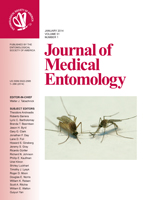Musca autumnalis DeGeer were collected in the summer and fall of 2011 and 2012 from a beef cattle herd in southern California. Visual counts of Musca spp. on cattle faces were documented, and sweep net samples of face flies and other Diptera were also collected from cattle faces. Face flies dominated in the net collections, and 5–30 flies per face were common between early July and October 2011. Adult female M. autumnalis were dissected and examined for the presence of the host-specific nematode Paraiotonchium autumnale (Nickle). Overall, 67 of 887 (7.6%) adult face fly females were parasitized. M. autumnalis' ability to survive in such a southerly latitude (34° N) could reflect the rather temperate weather (coastal effects) and frequently irrigated pastures at the experimental site in southern California. Preliminary observations suggest that face flies disappear from cattle during winter, despite generally favorable temperatures for fly activity. This is a possible indication of diapause and should be examined further.
How to translate text using browser tools
1 January 2014
Musca autumnalis (Diptera: Muscidae) and the Host-Specific Nematode Paraiotonchium autumnale (Tylenchida: Iotonchiidae) in Southern California
Diane Soto,
Fallon E. Fowler,
Broc A. Sandelin,
Bradley A. Mullens
ACCESS THE FULL ARTICLE
It is not available for individual sale.
This article is only available to subscribers.
It is not available for individual sale.
It is not available for individual sale.

Journal of Medical Entomology
Vol. 51 • No. 1
January 2014
Vol. 51 • No. 1
January 2014
cattle
face fly
Musca autumnalis
nematode
Paraiotonchium autumnale




